Vaccines and the Midwit Effect, or: Why smart people seem to believe all manner of crazy things, and smarter people seem to believe them even harder

Some weeks ago, this Swedish study on the correlation between cognitive ability and readiness to accept Covid vaccination made the rounds. It irritated a lot of people, particularly in these circles, for appearing to support the observation that getting vaccinated is just something that more intelligent people do – and, by implication, that vaccination is more objectively rational.
The authors looked at first-dose vaccine uptake in a sample of over 753,000 Swedes aged between 42 and 59. All of the overwhelmingly male participants had also taken a cognitive ability test at age 18 in the course of enlisting with the Swedish armed forces. These test scores were reported on a 9-point or stanine scale. Those with the least intellectual capacity scored 1, and those with the greatest scored 9.
Their central finding is captured in this chart of first-dose vaccine uptake, measured in days from availability and broken down by cognitive stanine score:
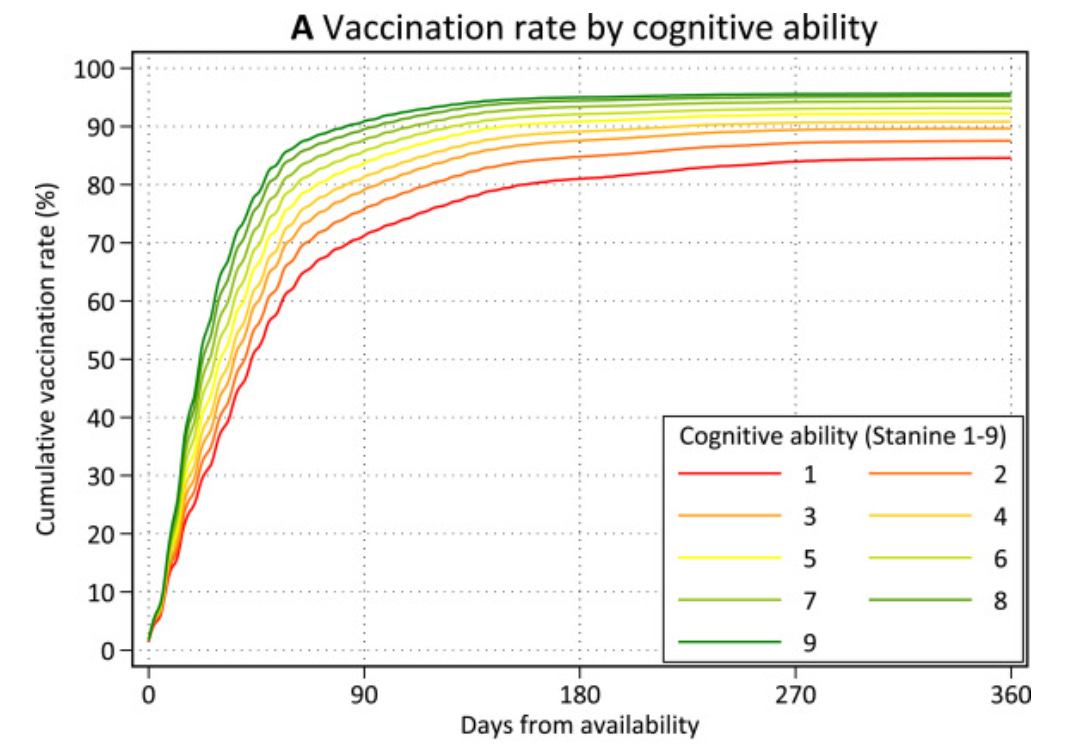
The smarter participants had higher uptake and they got vaccinated more quickly.
Uppsala provided pre-booked appointments for those 50 years of age and over. Here’s the effect that these appointments had on uptake among participants in that city:
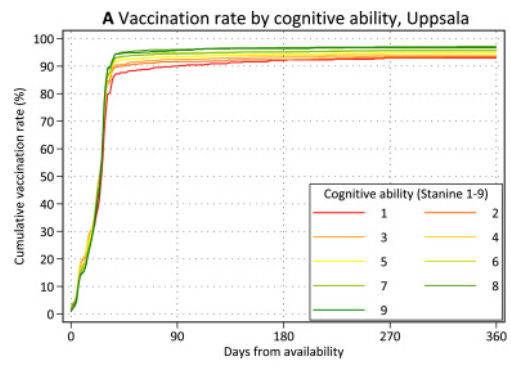
And here’s the effect of the pre-booked appointments on each cognitive group in Uppsala relative to participants of the same cognitive ability elsewhere in Sweden, who did not get pre-booked appointments:
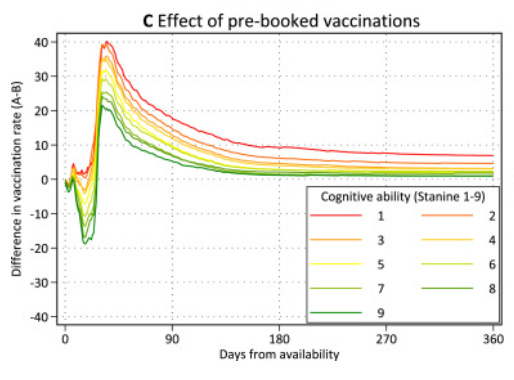
The micromanagement of personal medical decisions by health authorities in Uppsala substantially increased vaccine uptake across the whole population, though those of above-average cognitive ability initially ended up getting vaccinated somewhat more slowly than their counterparts elsewhere. They did not immediately run out the door for the new jabs, in other words, but rather waited for their assigned appointments.
Now, people have brought a wide range objections to this study. Some of them – for example, the insistence that tests cannot reliably measure cognitive ability – I just don’t find reasonable. Others were anticipated by the authors, who show that variables like personality, income, education and social background don’t explain the relationship as well as intelligence. Personally, I don’t have any objections to the findings; they’re what I would’ve expected. If you like, you can read them as an expression of the healthy vaccinee effect, which has confounded our statistics from the beginning. People who get vaccinated are on average healthier than those who don’t, and being healthy correlates strongly with having your head together. Whether the preferences and behaviours of people who have their heads together are always optimal or rational, is a much different question, but more on that anon.
Some perspective on the range of ability measured by these stanine scores will also help. All male participants in the study enlisted between 1979 and 1997, when military service was mandatory in Sweden. This means that study participants will be broadly representative of the Swedish population as a whole. Thus, those scoring 1 are not merely somewhat dull, but rather enlistees with substantial cognitive deficits. They’re people who struggle with literacy, who have trouble making sense of train timetables and for whom scheduling appointments represents a serious challenge. This is why the nudgers in Uppsala enjoyed such success with them. Conversely, those scoring 9 would represent, at worst, the equivalent of an above-average university student – the kinds of people work as doctors and lawyers. We hardly needed a study to tell us that the most enthusiastic vaccinators are to be found precisely in this population.
The midwit phenomenon is often misunderstood.
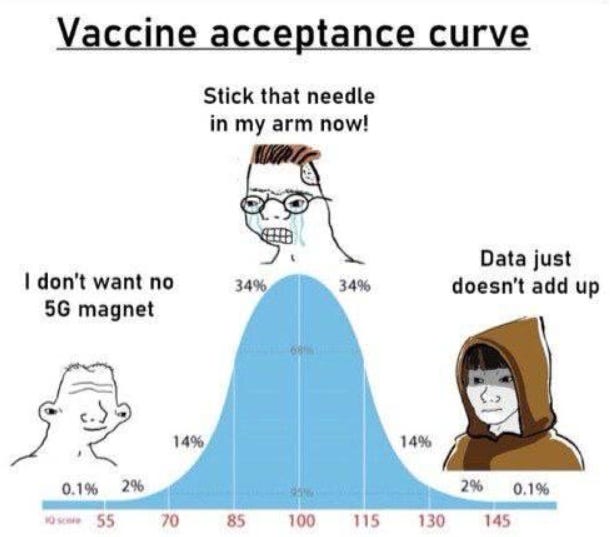
Contrary to this meme, midwits are not people of average intelligence (IQ 100), but rather those with cognitive scores of 8 or 9 in the Swedish study. A corrected version would look something like this:
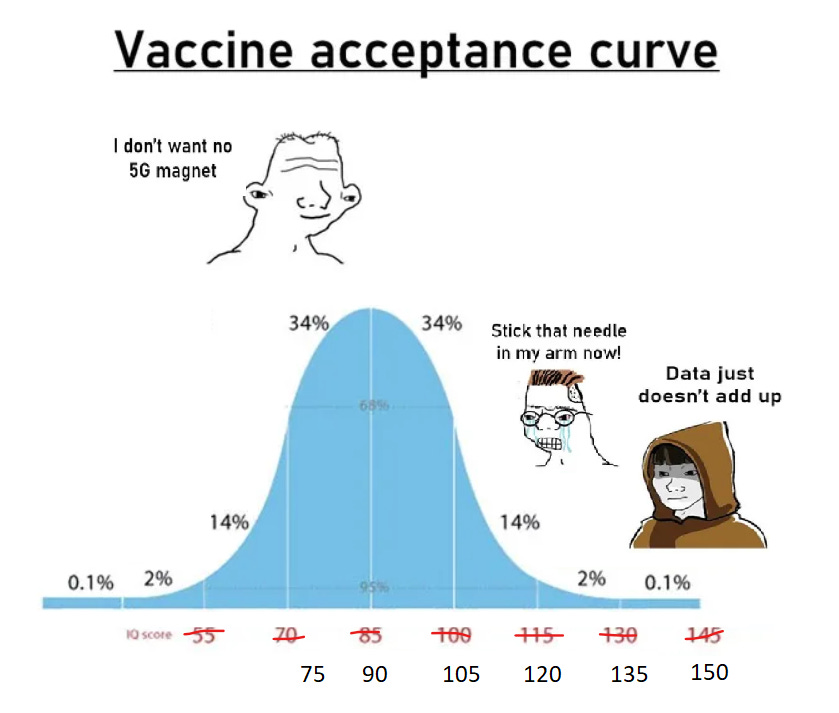
A long time ago, Dean Keith Simonton published an important paper on Intelligence and Personal Influence in Groups, which shows why it is that all of society seems to be dominated by the discourse of somewhat intelligent but never all-that-brilliant people. His central insight is that there exists a “range of comprehension” for a given level of intelligence. This is the range of less intelligent people who can still understand the reasoning of someone at the top of that range, and who are therefore susceptible to being persuaded by it. A near-genius with IQ 160 will be able to argue persuasively to his quite intelligent colleagues of IQ 140, but for the 50% of everyone with IQ 100, what he says will seem baffling. Because very few people are in the IQ 140–160 range, having IQ 160 is not very socially advantageous. If your goal is to make friends and influence people, it’s better to be substantially stupider.
This and other theoretical considerations lead Simonton to propose this chart of social influence (“potential adherents”) as a function of IQ:

Those who are of merely average intelligence don’t have much social influence at all. They find their intellectual superiors far more persuasive than their peers, at least to a point. Those who are very intelligent suffer from much the same disadvantage, because they are comprehensible only to a fairly small pool of slightly less intelligent people at the extrem right end of the curve.
Ours is therefore an IQ 120 midwit society; it could not be any other way. Those with the most influence have an upper comprehensive range extending to about IQ 140. They are still capable of internalising and mostly comprehending the criticism of the smartest professors. In the other direction, they look on the vast population of the unintelligent with a muted frustration, because their powers to persuade those with an IQ much below 100 are as weak as the power of their IQ 145 superiors is to persuade them. Since our midwit rulers are cognitively better endowed than probably 90% of the whole population, it’s easy for them to overlook the rare 10% of people who are smarter than they are. Accordingly, they throw all of their opponents into the same basket of intellectual deplorables, and commit themselves to unceasing wars against “disinformation,” to devising various social manipulation schemes and to banning the political opposition.
It follows that the ideas which dominate our world are not necessarily the best or the most rational approaches to things. They are rather those ideas which appeal to people whose intelligence is above average if less-than-phenomenal, and whose other personality traits optimise their institutional influence. They have the brains of upper middle-class professionals, and they’re also much more extroverted, conscientious and conformist than the broader population. In academia, where they dominate like nowhere else, we see a range of learned pathologies – not only a deep faith in irrational hygiene procedures like perpetual vaccination and masking, but a whole world of bizarre ideologies pertaining to human gender and biology, the environment and society. Something has obviously gone very wrong with these kinds of people, but – and this is the crucial point – those things which have gone wrong with them are calibrated precisely to that midwit peak. However irrational the ideas current in this sphere, their appeal will increase with intelligence up to a point that is very nearly out of sight from us, because people of outlier high intelligence are extremely rare and their influence is negligible.
This dynamic is the product of social, not rational, forces, which is why it is a grave mistake to assume that whatever the smart people happen to be doing at the moment is for that reason alone a good idea.